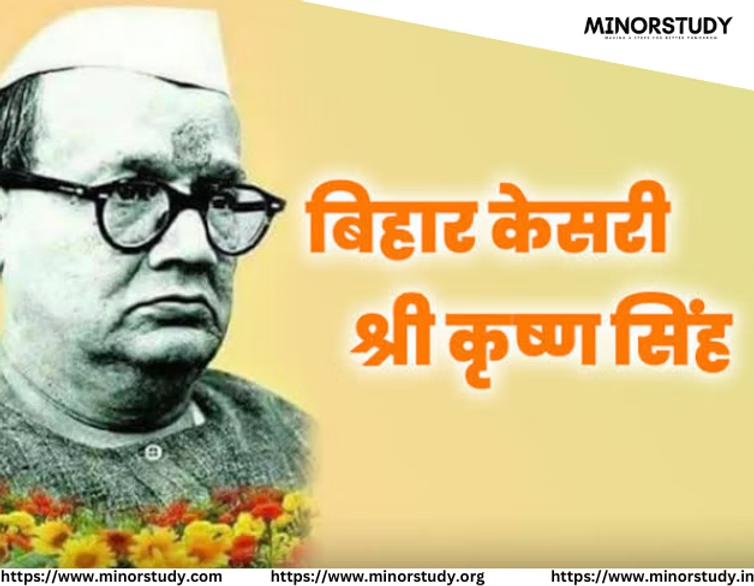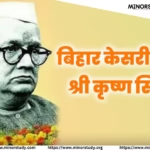9 Inspiring Facts About Bihar Kesari Dr. Sri Krishna Singh That Every Indian Should Know
Bihar Kesari: Among the towering figures of India’s freedom struggle and post-independence governance, Dr. Sri Krishna Singh—affectionately known as Bihar Kesari (Lion of Bihar)—holds a position of pride and respect. Revered as the first Chief Minister of Bihar, he was a visionary statesman, a fearless freedom fighter, and a champion of social justice. His bold reforms and administrative prowess helped shape modern Bihar and inspired a generation of leaders across India.
- 🏛️ History of Bihar Kesari – A Life Devoted to Nation-Building
- 🔢 9 Inspiring Facts About Bihar Kesari Dr. Sri Krishna Singh
- 📅 Timeline of Key Events in His Life
- 🎯 Significance of Bihar Kesari’s Leadership
- 1. Land Reforms That Empowered Farmers
- 2. Industrial and Infrastructural Growth
- 3. Pioneer of Inclusive Governance
- 4. Role Model of Ethical Politics
- 🧠 Frequently Asked Questions (FAQs)
- Q1: Why is Dr. Sri Krishna Singh called Bihar Kesari?
- Q2: What was his role in the Indian freedom movement?
- Q3: What were his major achievements as CM?
- Q4: When did Dr. Sri Krishna Singh die?
- Q5: Who was his political associate?
- 🎉 Observance and Honoring the Legacy
- 💌 Wishing Messages to Honor Bihar Kesari’s Legacy
- 🧩 Why Bihar Kesari Is Important in Our Life
- 1. For Farmers and Rural India
- 2. For Students and Scholars
- 3. For Social Justice
- 4. For Politicians and Bureaucrats
- 5. For the Common Citizen
- 📌 Key Points to Remember
- 🧭 Conclusion: Bihar Kesari’s Impact on Daily Life and Indian Society
Let us dive deep into the life, achievements, and ongoing legacy of this courageous leader who redefined leadership in post-colonial India.
🏛️ History of Bihar Kesari – A Life Devoted to Nation-Building
Dr. Sri Krishna Singh, born on October 21, 1887, in Nawada district of Bihar, was a remarkable freedom fighter and statesman. Deeply inspired by Mahatma Gandhi and Lokmanya Tilak, he joined the freedom movement in the early 1920s.
He was repeatedly jailed by British authorities, but that never dimmed his resolve. As a powerful orator, he roused the masses and mobilized thousands in Bihar to stand up against colonial rule.
After independence, he became the first Chief Minister of Bihar and held the post from 1946 until his death in 1961. During his tenure, he introduced progressive reforms in land, industry, education, and social equality. He worked alongside Dr. Anugrah Narayan Sinha, his close confidante and deputy, to turn Bihar into a model state during the Nehruvian era.
🔢 9 Inspiring Facts About Bihar Kesari Dr. Sri Krishna Singh
First Chief Minister of Bihar
Dr. Sri Krishna Singh took office in 1946 and led Bihar through critical years of nation-building.Architect of Land Reforms in Bihar
He abolished the Zamindari system, one of the most revolutionary moves in Indian post-independence history, aiming to end feudal exploitation.A Close Ally of Mahatma Gandhi
Singh actively participated in the Non-Cooperation and Quit India Movements, aligning himself ideologically with Gandhiji.An Education Reformer
Under his leadership, institutions like Patna University received major infrastructural and academic boosts.A Champion of Dalits and Backward Classes
He implemented policies that promoted reservation and inclusivity in public services and education.An Impeccable Orator and Writer
His speeches were fiery, purposeful, and filled with a vision for a self-reliant Bihar.One of the Longest-Serving CMs in Indian History
Serving uninterrupted for 15 years, he shaped the foundational infrastructure of Bihar.Refused Special Privileges
He was known for living simply and rejecting VVIP status, embodying Gandhian ideals.Left a Lasting Legacy
Many institutions, roads, and colleges across Bihar are named after him to this day.
📅 Timeline of Key Events in His Life
| Year | Event |
|---|---|
| 1887 | Born in Maur, Nawada, Bihar |
| 1920 | Joins Non-Cooperation Movement |
| 1930 | Participates in Civil Disobedience Movement, arrested |
| 1942 | Actively leads Quit India Movement in Bihar |
| 1946 | Becomes the first CM of Bihar |
| 1950 | Launches major land reforms |
| 1952 | Wins first general election post-independence |
| 1961 | Passes away in office on January 31 |
🎯 Significance of Bihar Kesari’s Leadership
1. Land Reforms That Empowered Farmers
By abolishing Zamindari, he gave land rights back to the farmers, a courageous and unpopular move among elites but a boon for rural Bihar.
2. Industrial and Infrastructural Growth
Under his leadership, Bihar saw the development of industries in Bokaro, Dalmianagar, and Chota Nagpur, and electricity and water reforms were prioritized.
3. Pioneer of Inclusive Governance
He was one of the first Indian leaders to institutionalize social justice for backward classes and marginalized communities.
4. Role Model of Ethical Politics
He remained untainted by corruption, often cited as one of the most honest and selfless leaders of his time.
🧠 Frequently Asked Questions (FAQs)
Q1: Why is Dr. Sri Krishna Singh called Bihar Kesari?
Answer: He earned the title Bihar Kesari (Lion of Bihar) for his bravery, bold leadership, and relentless efforts toward social justice and Indian independence.
Q2: What was his role in the Indian freedom movement?
Answer: He played a pivotal role in the Non-Cooperation, Civil Disobedience, and Quit India Movements and was repeatedly imprisoned by the British.
Q3: What were his major achievements as CM?
Answer: Abolition of Zamindari, promotion of education, industrialization, and welfare reforms for backward classes.
Q4: When did Dr. Sri Krishna Singh die?
Answer: He passed away on January 31, 1961, while still serving as the Chief Minister.
Q5: Who was his political associate?
Answer: Dr. Anugrah Narayan Sinha, his deputy and confidant, played a vital role in implementing reforms.
🎉 Observance and Honoring the Legacy
In Bihar and Beyond:
Annual functions and tributes are held across Bihar on October 21 (his birthday) and January 31 (his death anniversary).
Educational institutions conduct debates, essay competitions, and lectures on his life and work.
Statues, public places, and roads are named after him, especially in Patna, Nawada, and Begusarai.
💌 Wishing Messages to Honor Bihar Kesari’s Legacy
“On this day, we salute Bihar Kesari, the Lion of Bihar, for his bold reforms and eternal legacy.”
“Let’s remember Dr. Sri Krishna Singh Ji—the true architect of Bihar’s foundation—with pride and gratitude.”
“May the ideals of justice, equality, and simplicity of Bihar Kesari inspire generations to come.”
🧩 Why Bihar Kesari Is Important in Our Life
1. For Farmers and Rural India
His land reforms allowed landless peasants to become owners, a moment of economic liberation.
2. For Students and Scholars
He built educational institutions that nurtured Bihar’s intellectual culture and raised literacy levels.
3. For Social Justice
His efforts uplifted Dalits, OBCs, and marginalized groups, making governance more inclusive.
4. For Politicians and Bureaucrats
He demonstrated that power with integrity is possible, setting a moral benchmark for public life.
5. For the Common Citizen
His legacy lives in the electricity, schools, and land rights we now take for granted in Bihar.
📌 Key Points to Remember
Birth: October 21, 1887
Death: January 31, 1961
Title: Bihar Kesari (Lion of Bihar)
First CM of Bihar: 1946–1961
Major Reforms: Abolition of Zamindari, Inclusive Education, Dalit Welfare
Ideology: Gandhian, Socialist, Ethical Governance
🧭 Conclusion: Bihar Kesari’s Impact on Daily Life and Indian Society
Dr. Sri Krishna Singh was not just a leader—he was a visionary, a crusader for justice, and a selfless servant of the people. The roads we walk on, the schools we learn in, and the lands we farm in Bihar are rooted in his policies and dreams. His story teaches us the value of courage, ethics, and inclusivity in leadership.
In daily life, his influence lingers in social equity laws, education systems, and democratic structures. For India as a whole, Bihar Kesari is a symbol of strength with humility—a leader who roared like a lion but served with the heart of a humble human being.








